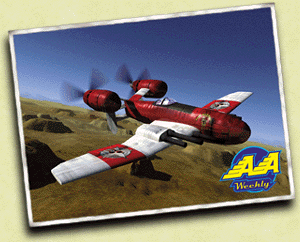
 |
|
||||||||||||||||
 |

Aircraft In Review  Featured Aircraft: The Sanderson FB14
Featured Aircraft: The Sanderson FB14By Lance "Lightning" Hawkins
Since its introduction in 1934, the Sanderson FB14 (nicknamed the "Vampire") has built itself an impressive reputation as both a powerful fighter craft and as a light bomber. Flown by agents of the Texas government, and favored by one of the deadliest pirates in the air today, the Vampire "combines the firepower and sturdiness that today's hottest pilots demand" (according to Sanderson's sales staff). But does it live up to its billing? The Test After a tour of the main factory floor—conducted by none other than company president Matthew Sanderson himself—I was escorted to the "test facility" (little more than a long, flat field on the outskirts of Tulsa). The plane itself was a stock factory model, built for combat (rather than one of the cargo or reconnaissance birds that are the most common variants). With a full load of rockets, bombs and ammunition, I was struck by just how fierce the FB14 looks. Powerful But Slow Despite handling that could best be termed "sluggish" and "cumbersome," the FB14 showed remarkable steadiness and ease of control when making strafing attacks and bombing runs, using it's array of weaponry to great effect. The Vampire's twin Pratt and Whitney P12 engines deliver a great deal of power (1,590 horsepower), with minimal fuel consumption. The FB14's flight ceiling is also impressive: the Vampire can attain a height of 25,000 feet. High Maintenance Gunslinger In three passes, the ground targets were completely obliterated, showcasing the Vampire's robust and stable handling in low-level attacks. Against the point-defense balloons, however, the Vampire did not fare so well. I managed to tag the first couple balloons with rockets, but missed the third, since the plane's turning radius was too wide. Evaluation Lance "Lightning" Hopkins is a longtime contributor to AAW. He won the prestigious Hughes Award for his coverage of the Plateau Wars of 1936.
|